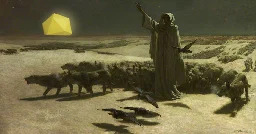Permanently Deleted
SkyyHigh @ SkyyHigh @ttrpg.network Posts 10Comments 37Joined 2 yr. ago
SkyyHigh @ SkyyHigh @ttrpg.network
Posts
10
Comments
37
Joined
2 yr. ago
The History of DnD that Hasbro Refused to Learn From - Extra Credits
Clarifying Language: One D&D, 2024 Core Rulebooks
Reference: All OneDnD (PHB-2024) Playtest Material






They probably mistyped "immoral".